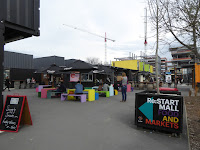 |
| Paddington Reservoir Gardens |
Sydney is one of those cities that everyone has heard of, perhaps because The Sydney Opera House is one of those iconic landmarks that everyone recognises. Add to that the Sydney Harbour Bridge, Bondi Beach, a host of bars and restaurants, and at least the perception of perpetual sunshine, and you have a city that features on most people's travel wishlist.
One of the things that we like about London, is that it is almost a series of small towns and villages, each of which have their own character. Some great, some not so great, but they all add to the diversity and flavour of the city. Sydney is very much like this too. There were some areas that we thought were lovely, and would return to time and again, and others that we could happily live without.
 |
| University of Sydney |
Just to the west of Kings Cross, you can take one of the staircases down to the wonderfully named area of Woolloomooloo, which has a few places to eat, and leads on to the Royal Botanic Gardens and then to The Harbour area and Opera House. But we'll come back to that later.
South of Kings Cross takes you through Darlinghurst, which has a few nice cocktail bars, such as 'Eau de Vie' and 'Love Tilly Devine'. Whilst there are no particular 'attractions', is quite a pleasant walk through Darlinghurst, with plenty of places that you can stop off for a drink, and there are quite a few art galleries if that interests you.
From Darlinghurst you can continue walking on to Paddington, Newtown and Surrey Hills.
 |
| Chippendale |
Paddington Reservoir Gardens, which is an old water reservoir that went out of use in 1899 and was transformed into a sunken garden in 2009. And then there is the Paddington Market, which is on every Saturday, and has many interesting stalls from lots of local artisans. I was tempted by many pieces, but restricted myself to a bright red ring made on a 3D printer, and a Sydney Opera House charm for my bracelet.
Our favourite area was Newtown. It had a far more down to earth feel, with great bars and interesting shops. Sadly, Holy Kitsch!, a shop that specialised in Day of the Dead style skulls of various forms, wasn't quite as good as we had hoped it would be. This was a good place to wander around, with some decent cafes and bars, including the deservedly very popular Brewtown Newtown - if you go, do try the doughnuts.
Surrey Hills was good too, again, quite a few decent cafes and bars. This was one of those areas that is good for people watching, with a good range of people coming in. It does feel a bit like an area in transition, like it may lose some of its more interesting side to a more uniformly upscale style; I do hope it doesn't, as it has a great mix at present.
 |
| White Rabbit Collection |



















































